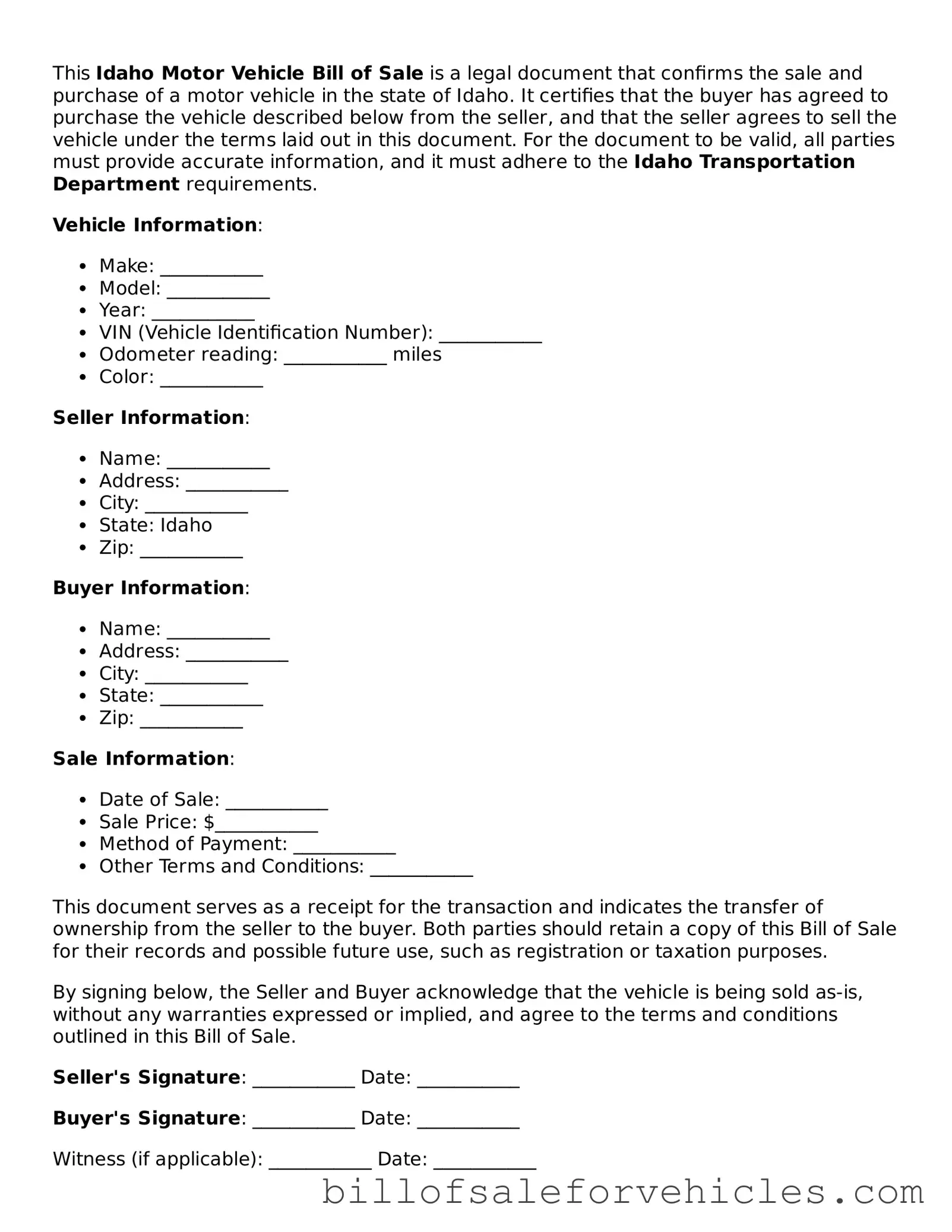What is an Idaho Motor Vehicle Bill of Sale?
An Idaho Motor Vehicle Bill of Sale is a legal document that records the sale of a vehicle in the state of Idaho, providing essential details such as the buyer, seller, vehicle information, and the sale price. It serves as a proof of purchase and can be required for vehicle registration and title transfer processes.
Do I need a Bill of Sale to sell a vehicle in Idaho?
Yes, when selling a vehicle in Idaho, it is recommended to complete a Bill of Sale. This document provides a record of the transaction and is necessary for the legal transfer of ownership. Although not always mandatory for the sale process, it is crucial for the buyer’s registration and titling of the vehicle.
What information should be included in an Idaho Motor Vehicle Bill of Sale?
The Idaho Motor Vehicle Bill of Sale should include the full names and addresses of both the seller and the buyer, a detailed description of the vehicle (including make, model, year, and VIN), the sale price, date of sale, and signatures of both parties involved. Including an odometer reading is also essential for a complete record.
Is notarization required for an Idaho Motor Vehicle Bill of Sale?
Notarization is not required for an Idaho Motor Vehicle Bill of Sale to be considered valid. However, having the document notarized can add an extra layer of authenticity and may be beneficial in preventing legal issues related to the sale.
Can I use an Idaho Motor Vehicle Bill of Sale form for selling a boat?
No, the Idaho Motor Vehicle Bill of Sale is specifically designed for transactions involving motor vehicles. For selling a boat, you should use a Bill of Sale form that is specifically designed for boat transactions, complying with Idaho’s regulations for boat sales.
Where can I find an Idaho Motor Vehicle Bill of Sale form?
An Idaho Motor Vehicle Bill of Sale form can be downloaded from the Idaho Transportation Department's website or other reputable legal documents websites. Ensure that the form you use complies with Idaho state requirements.
Can I write my own Bill of Sale for a vehicle sale in Idaho?
Yes, you can write your own Bill of Sale for a vehicle sale in Idaho. Make sure to include all required information, such as the names and addresses of the buyer and seller, vehicle details, sale price, and sale date. Both parties should sign the document to validate it.
How does a Bill of Sale protect the buyer and seller?
A Bill of Sale protects the buyer by providing proof of ownership and the terms of the sale, which can be crucial for registration and titling of the vehicle. For the seller, it offers proof that the transfer of ownership has occurred, safeguarding against future claims or liabilities related to the vehicle.
After completing a Bill of Sale, what are the next steps?
After the Bill of Sale is completed and signed, the buyer should submit it along with the necessary documents to the Idaho Transportation Department for vehicle registration and title transfer. The seller should keep a copy for their records to ensure documentation of the transaction.
Does a Bill of Sale need to be filed with the Idaho Department of Motor Vehicles?
A Bill of Sale does not need to be filed directly with the Idaho Department of Motor Vehicles. However, it should be submitted as part of the necessary documentation for vehicle registration and title transfer by the new owner. Keeping a copy for personal records is also advisable.
